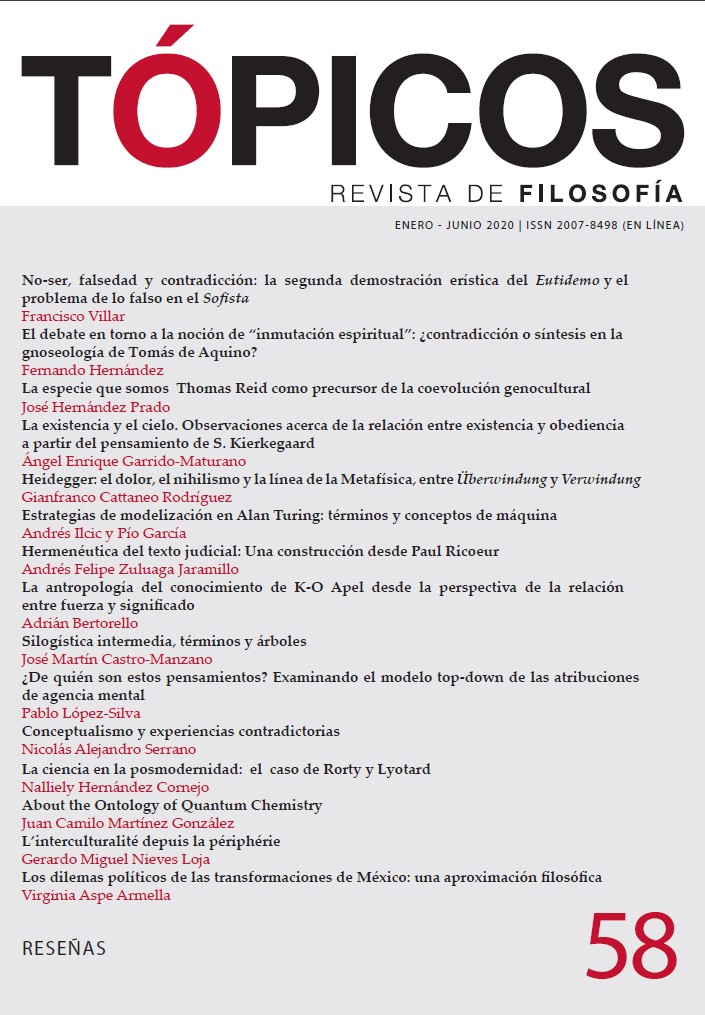Publicado 2019-12-13
Palabras clave
- ilusión de cascada,
- experiencia perceptiva,
- contenido no-conceptual,
- contenido conceptual
Cómo citar
Resumen
En este trabajo ofrezco una respuesta conceptualista al argumento de la ilusión de cascada (Crane 1988a, 1988b) en el marco del debate representacionalista acerca del tipo de contenido de la experiencia perceptiva. En primer lugar, analizo la estructura general del argumento, según la cual el contenido supuestamente contradictorio de ciertas ilusiones ópticas mostraría que el contenido de la experiencia perceptiva es de tipo no-conceptual. En segundo lugar, discuto una serie de respuestas conceptualistas con el fin de mostrar por qué no resultan satisfactorias. Finalmente, defiendo una respuesta conceptualista que denomino “disociativa”, según la cual el contenido de la ilusión de cascada no es de hecho contradictorio.
Descargas
Referencias
- Aristóteles. (1987). De Insomniis (traducido como “Acerca de los ensueños” por Pachecho, S.). En Acerca de la Generación y la Corrupción. (pp. 277-294). Madrid: Gredos.
- Braddick, O. (2010). Motion Perception. En E. B. Goldstein (ed.), Encyclopedia of Perception. (pp. 571-577). Londres: SAGE Publications Inc.
- Brewer, B. (1999). Perception and Reason. Oxford: Oxford University Press.
- Brewer, B. (2001). Précis of Perception and Reason. Philosophy and Phenomenological Research, 63(2), 405-416.
- Brewer, B. (2005). Perceptual eExperience has Conceptual Content. En E. Sosa y M. Steup (eds.), Contemporary Debates in Epistemology. (pp. 217-230). Oxford: Blackwell.
- Byrne, A. (2005). Perception and Conceptual Content. En E. Sosa y M. Steup (eds.), Contemporary Debates in Epistemology. (pp. 231-250). Oxford: Blackwell.
- Clifford, C. W. G. (2010). Afterimages. En E. B. Goldstein (ed.), Encyclopedia of Perception. (pp. 13-16). Londres: SAGE Publications Inc.
- Crane, T. (1988a). The Waterfall Ilussion. En Y. H. Gunther (ed.), Essays on Nonconceptual Content. (pp. 231-236). Cambridge: MIT Press.
- Crane, T. (1988b). Concepts in Perception. Analysis, 48(3), 150-153.
- Einhäuser, W., Martin, K. A. C. y König, P. (2004). Are Switches in Perception of the Necker Cube Related to Eye Position? European Journal of Neuroscience, 20, 2811-2818.
- Evans, G. (1982). The Varieties of Reference. Oxford: Oxford University Press.
- Fodor, J. (1983). The Modularity of Mind. Cambridge: MIT Press.
- Frege, G. (1892). Über Sinn und Bedeutung. En Zeitschrift für Philosophie und philosophische Kritik, 100, 25-50. (Traducido como “On Sense and Reference” en P. Geach y M. Black. (1980). Translations from the Philosophical Writings of Gottlob Frege. (pp. 56-78). Oxford: Blackwell).
- Frisby, J. (1979). Seeing: Illusion, Brain and Mind. Oxford: Oxford University Press.
- Goldstein, E. B. (2010). Encyclopedia of Perception. Londres: SAGE Publications Inc.
- Gunther, Y. H. (2001). Content, Illusion, Partition. Philosophical Studies: An International Journal for Philosophy in the Analytic Tradition, 102 (2), 185-202.
- Gunther, Y. H. (2003). Essays on Nonconceptual Content. Cambridge: MIT Press.
- Hamlyn, D. W. (1994). Perception, Sensation, and Nonconceptual Content. Reeditado en Y. H. Gunther (ed.), Hamlyn, D. W. (2003). Essays on Nonconceptual Content (pp. 251-262). Cambridge, Massachusetts: The MIT Press.
- Heck, R. G. (2000). Non-Conceptual Content and the ‘Space of Reasons’. The Philosophical Review, 109(4), 483-523.
- Heck, R. G. (2007). Are There Different Kinds of Content? En Brian P. McLaughlin y Jonathan D. Cohen (eds.), Contemporary Debates in Philosophy of Mind. (pp. 117-138). Oxford: Blackwell.
- Marr, D. (1982). Vision. San Francisco: Freeman and Co.
- Martinez-Conde, S. y Macknik, S. L. (2010). Visual Illusions. En E. B. Goldstein (ed.), Encyclopedia of Perception. (pp. 1077-1081). Londres: SAGE Publications Inc.
- McCauley, R. N. y Henrich, J. (2006). Susceptibility to the Müller-Lyer Illusion, Theory-Neutral Observation, and the Diachronic Penetrability of the Visual Input System. Philosophical Psychology, 19, 79-101.
- McDowell, J. (1994). Mind and World. Cambridge: Harvard University Press.
- McDowell, J. (1996). Afterword. En Mind and World. 2da. ed. (pp. 129-187). Cambridge: Harvard University Press.
- McDowell, J. (1998). Reply to Commentators. Philosophy and Phenomenological Research, 58(2), 403-431.
- McDowell, J. (2009). Having the World in View: Essays on Kant, Hegel, and Sellars. Cambridge: Harvard University Press.
- Mellor, D. H. (1988). Crane’s Waterfall Illusion. Analyisis, 48(3),147-150.
- Peacocke, C. (1992). Scenarios, Concepts, and Perception. Reeditado en Y. H. Gunther (ed.), (2003). Essays on Nonconceptual Content. (pp. 107-132). Cambridge, Massachusetts: The MIT Press.
- Russell, B. (1912). The Problems of Philosophy. Londres: Williams and Norgate; Nueva York: Henry Holt and Company.
- McDowell, J. (1940). An Inquiry into Meaning and Truth. Londres: George Allen and Unwin. Nueva York: W.W. Norton.
- Skidelsky, L. (2010). Contenido conceptual - no conceptual y vehículos representacionales. En D. Pérez, S. Español, L. Skidelsky y R. Minervino (comps.), Conceptos. Debates contemporáneos en filosofía y psicología. (pp. 65-101). Buenos Aires: Catálogos.
- Speaks, J. (2005). Is There a Problem about Nonconceptual Content? The Philosophical Review, 114(3), 359-398.






